|
Introduction
Not knowing anything about the island before I came, I rather expected that it would be full of colorful Hindu temples but not much more than a few hundred years old. It turns out that the island does have a history of Hindu influence from India, but it has a much bigger and older influence from Buddhist elements with remains going back more than a thousand years. Before Colombo (actually Sri Jayawardenepura is the capital now) there were a number of centers of power which ruled over parts of the island even after the colonizers came in and slowly ate-up the island. Kandy was the last of these regional capitals which fell to the British in 1815. Anyway, this plethora of ancient capitals leads to an impressive string of partial remains from the building sprees of each king. I visited a couple of the more famous sights.
Dambulla
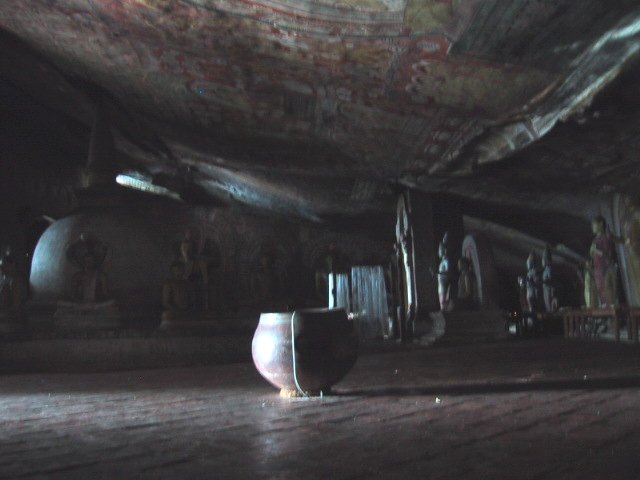
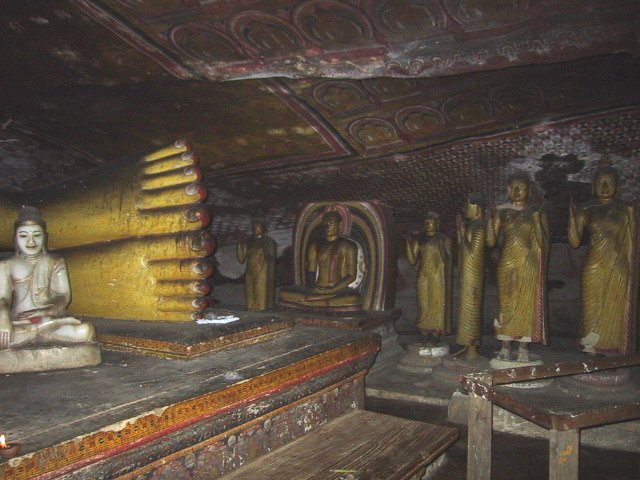 Actually, this first stop was never actually a capital, but rather the residence for an exiled king in the 6th century. The story goes that he hung out in these caves for a number of years while someone else ruled from Anapuradara, 100km or so away. When the king made his return to power, he turned these caves into a natural temple by requisitioning frescoes to be painted on the ceilings and adding a steady collection of statues and idols over time. It is not easy to see what each little statue means or when the different frescoes were painted (the word is that they were restored a couple times, most recently in the 18th century), but the place is impressive simply based on the feeling of the place. It is a long walk up the rocks to get to this cave, but one can definitely see how this made a good hide-out for a king and also makes a good place of worship.
Actually, this first stop was never actually a capital, but rather the residence for an exiled king in the 6th century. The story goes that he hung out in these caves for a number of years while someone else ruled from Anapuradara, 100km or so away. When the king made his return to power, he turned these caves into a natural temple by requisitioning frescoes to be painted on the ceilings and adding a steady collection of statues and idols over time. It is not easy to see what each little statue means or when the different frescoes were painted (the word is that they were restored a couple times, most recently in the 18th century), but the place is impressive simply based on the feeling of the place. It is a long walk up the rocks to get to this cave, but one can definitely see how this made a good hide-out for a king and also makes a good place of worship.
Sigiriya
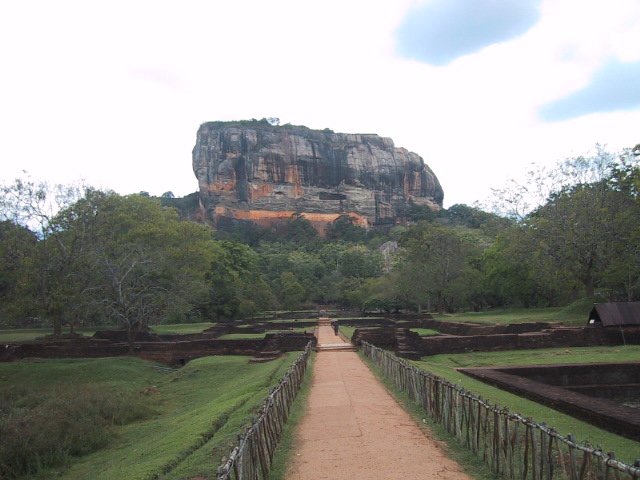
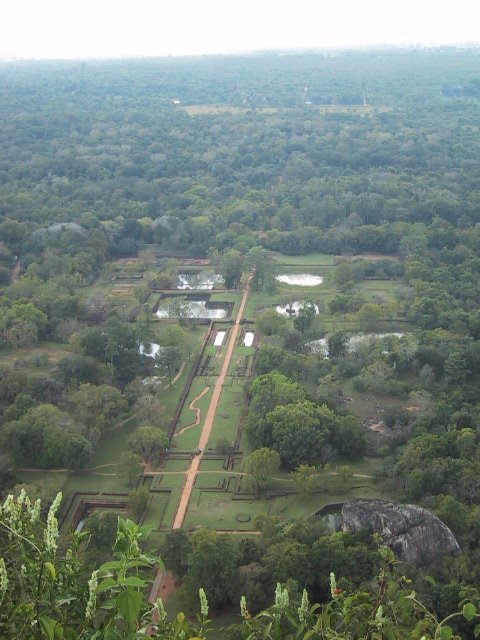 An even longer climb up an even steep rock, wins you a look at this impressive sight. Only about 30km away from Dumballa and another 30 or so from Polonnaruwa (see below), this place was the capital of the area for a short time in the 11th century. The king here was a bit afraid of his brother coming back to kill him, so he chose this odd rock formation, surrounding by relatively flat plains as a perfectly defensable seat of power. In addition to the virtually impenetrable palace atop the lion rock, the king also assembled an impressive summer palace at the foot of the rock. The whole complex included housing for the common people (and assumedly the laborers who built this place up in less than ten years), an impressive public garden, with water collection and bathing facilities. All of this was surrounded by a couple moats which were populated with crocodiles, just in case.
An even longer climb up an even steep rock, wins you a look at this impressive sight. Only about 30km away from Dumballa and another 30 or so from Polonnaruwa (see below), this place was the capital of the area for a short time in the 11th century. The king here was a bit afraid of his brother coming back to kill him, so he chose this odd rock formation, surrounding by relatively flat plains as a perfectly defensable seat of power. In addition to the virtually impenetrable palace atop the lion rock, the king also assembled an impressive summer palace at the foot of the rock. The whole complex included housing for the common people (and assumedly the laborers who built this place up in less than ten years), an impressive public garden, with water collection and bathing facilities. All of this was surrounded by a couple moats which were populated with crocodiles, just in case.
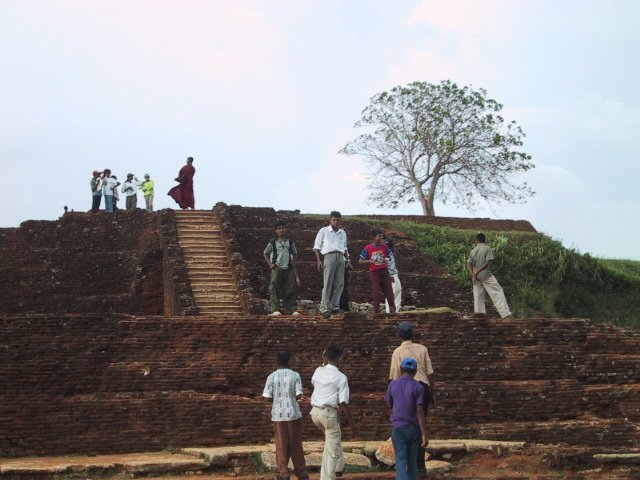 I suppose some people might find this to just be a pile of rocks, but ever since I saw my first ancient ruins in Turkey, I have been fascinated with such sights. It is amazing what people were able to make back in the day. Some of the things I have seen would seem nearly impossible to build even now with the technology and equipment that we have. I guess that ancient societies generally compensated for technology by using sheer power, often driven by masses of desperate people, but still it is impressive. Just as I was admiring the scene and thinking how peaceful it would be to live atop lion rock, a fierce storm blew up with rain and wind. Suddenly the place seemed like a rather dumb place for a home as the wind gusting over the lip of the rock nearly blew me over the cliff. Still, I give these people credit for having a crazy vision and building something that still remains, at least in ruins, today.
I suppose some people might find this to just be a pile of rocks, but ever since I saw my first ancient ruins in Turkey, I have been fascinated with such sights. It is amazing what people were able to make back in the day. Some of the things I have seen would seem nearly impossible to build even now with the technology and equipment that we have. I guess that ancient societies generally compensated for technology by using sheer power, often driven by masses of desperate people, but still it is impressive. Just as I was admiring the scene and thinking how peaceful it would be to live atop lion rock, a fierce storm blew up with rain and wind. Suddenly the place seemed like a rather dumb place for a home as the wind gusting over the lip of the rock nearly blew me over the cliff. Still, I give these people credit for having a crazy vision and building something that still remains, at least in ruins, today.
Polonnaruwa
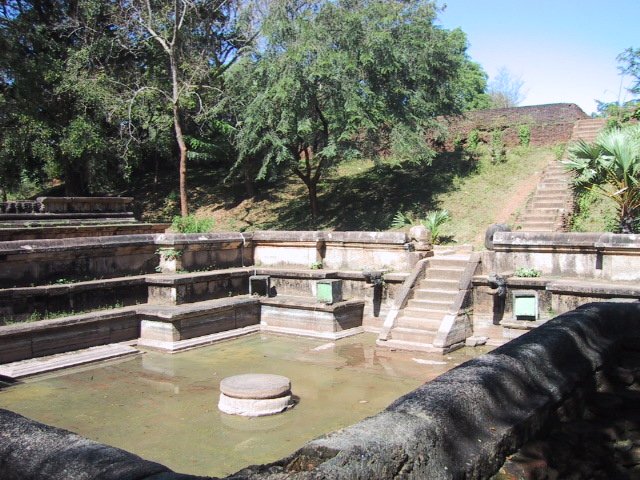
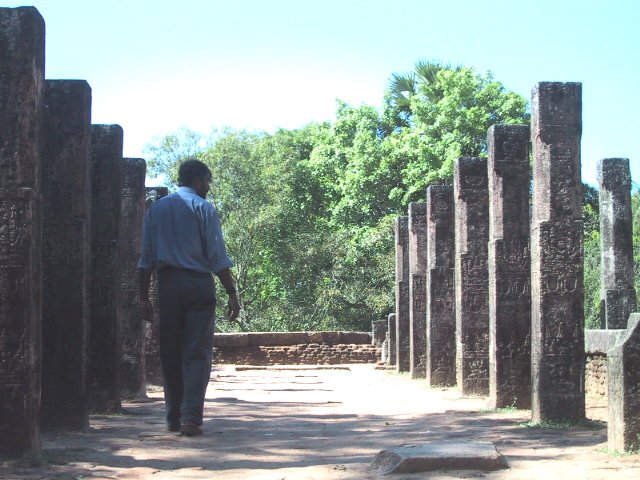 My third main stop on the tour of ruins was the capital of Polonnaruwa. Unlike Sigiriya, this place was built-up over the lifetime of three kings instead of just one. And the reach of the empire at this time seemed to be a bit more too. In addition to the palace, bath, and gardens, there was also a parliament house, though probably no more than twenty representatives would fit in this hall. One can imagine where the commoners must have lived, though these homes (like in Roman and Greek times) were probably wooden or made from other substances that are no longer around these days. Actually, they say that the palace itself was more than half wooden, as well, so that the impressive rock remains you see only account for three of the original seven storeys of this building.
My third main stop on the tour of ruins was the capital of Polonnaruwa. Unlike Sigiriya, this place was built-up over the lifetime of three kings instead of just one. And the reach of the empire at this time seemed to be a bit more too. In addition to the palace, bath, and gardens, there was also a parliament house, though probably no more than twenty representatives would fit in this hall. One can imagine where the commoners must have lived, though these homes (like in Roman and Greek times) were probably wooden or made from other substances that are no longer around these days. Actually, they say that the palace itself was more than half wooden, as well, so that the impressive rock remains you see only account for three of the original seven storeys of this building.
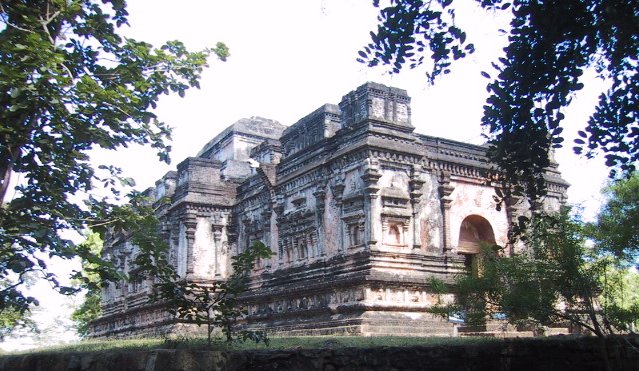 Perhaps the most impressive thing, and something that was absent at Sigiriya, is the various temples, shrines, and a monks' university (?) that seems to take up more than two-thirds of the space here. Like modern Sri Lanka, the people and the government in Polonnaruwa times were primarily Buddhist Sinhalese, but they made efforts to incorporate the Tamil Hindus into daily life. The Hindu shrines that you find in the walled ruins are always smaller than the temples, but the fact that they were allowed within the grounds shows some amount of tolerance.
Perhaps the most impressive thing, and something that was absent at Sigiriya, is the various temples, shrines, and a monks' university (?) that seems to take up more than two-thirds of the space here. Like modern Sri Lanka, the people and the government in Polonnaruwa times were primarily Buddhist Sinhalese, but they made efforts to incorporate the Tamil Hindus into daily life. The Hindu shrines that you find in the walled ruins are always smaller than the temples, but the fact that they were allowed within the grounds shows some amount of tolerance.
The Quadrangle
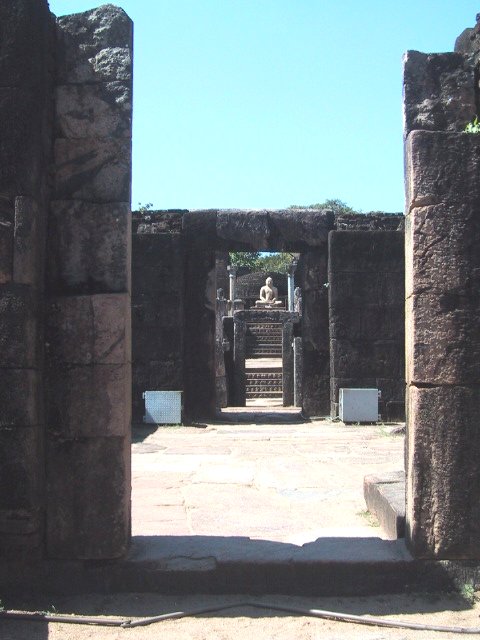
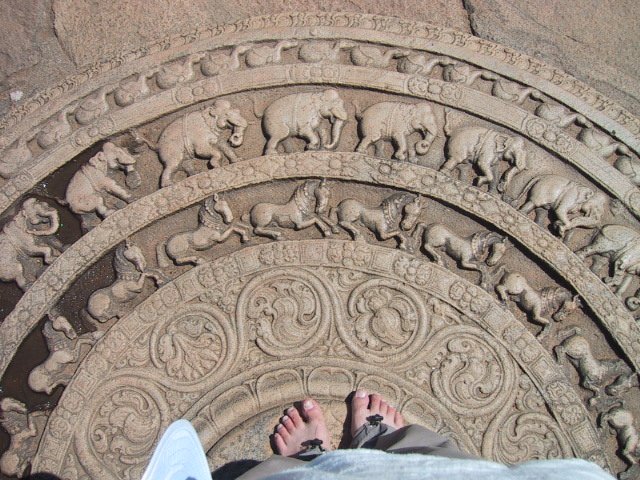 Of course, the main religious complex at Polonnaruwa is raised above the nearby Hindu shrine to Shiva. The quadrangle was the area where each king build more and more impressive tributes and temples to house the tooth relic (see the Kandy section) which was a key to the rule of the area and was basically passed from ruler to ruler all the way to Kandy. My favorite of these temples is a circular structure with entrances on each of the four cardinal points. To enter at these points, you pass over a moonstone that is almost perfectly preserved and ascend stairs that still retain their ancient decorative carvings. The stupa-like mound that forms the center of the building is said to be empty, though some say it was meant to be the third hall for the tooth relic before the capital moved yet again.
Of course, the main religious complex at Polonnaruwa is raised above the nearby Hindu shrine to Shiva. The quadrangle was the area where each king build more and more impressive tributes and temples to house the tooth relic (see the Kandy section) which was a key to the rule of the area and was basically passed from ruler to ruler all the way to Kandy. My favorite of these temples is a circular structure with entrances on each of the four cardinal points. To enter at these points, you pass over a moonstone that is almost perfectly preserved and ascend stairs that still retain their ancient decorative carvings. The stupa-like mound that forms the center of the building is said to be empty, though some say it was meant to be the third hall for the tooth relic before the capital moved yet again.
More Temples
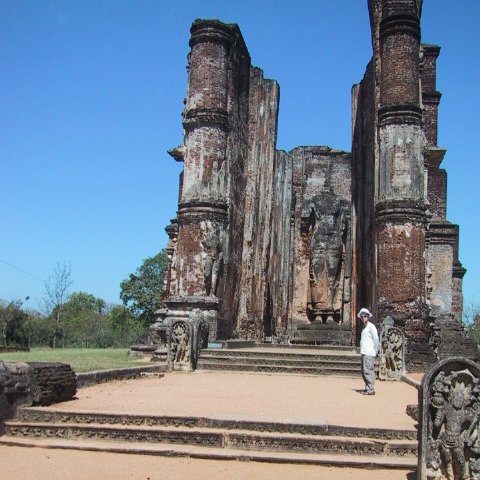
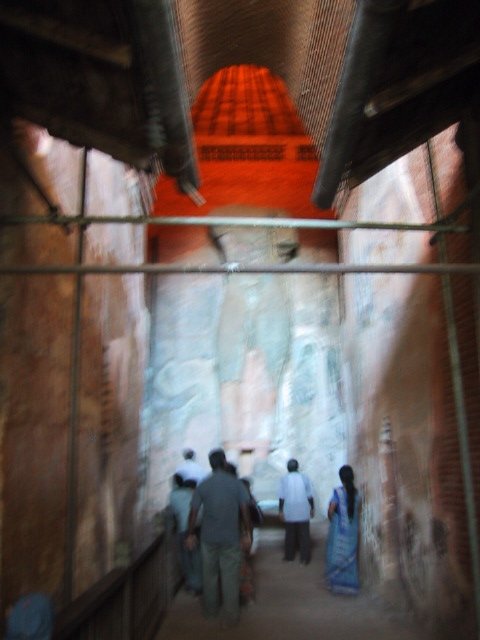 These three kings really liked their temples, or maybe it was the influence of the many monks studying and living on the north end of the city, at any rate, the structures just go on and on. You really need a car or bicycle to see the ruins further up the road. The most impressive of these temples is the on far north of the city. It has been partially reconstructed now to include the original dome over the main statue. The walls also display a number of frescoes which are being repainted as well. But my favorite, was the sculptures that adorn the entire perimeter of the building. These little detailed carvings are more impressive to me than the massive Buddhas carved into a rock at the end of the site.
These three kings really liked their temples, or maybe it was the influence of the many monks studying and living on the north end of the city, at any rate, the structures just go on and on. You really need a car or bicycle to see the ruins further up the road. The most impressive of these temples is the on far north of the city. It has been partially reconstructed now to include the original dome over the main statue. The walls also display a number of frescoes which are being repainted as well. But my favorite, was the sculptures that adorn the entire perimeter of the building. These little detailed carvings are more impressive to me than the massive Buddhas carved into a rock at the end of the site.
|